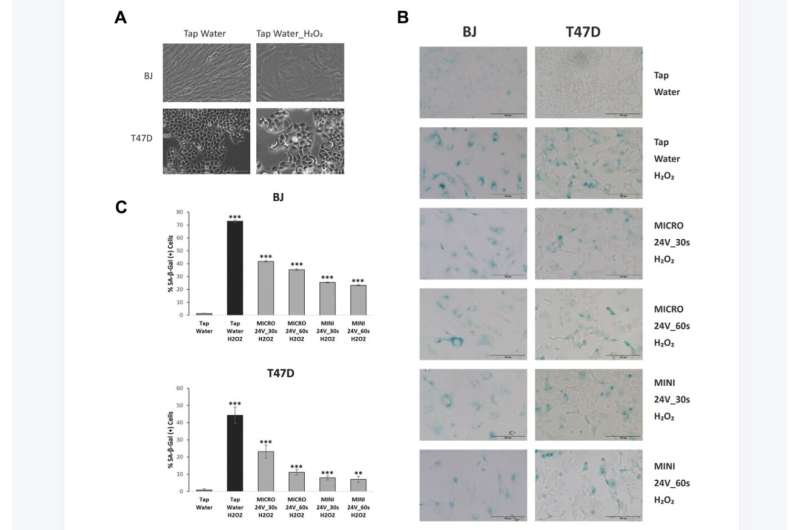This article has been reviewed according to Science X's editorial process and policies. Editors have highlighted the following attributes while ensuring the content's credibility:
fact-checked
proofread
Study investigates whether Weo electrolyzed water can modulate phenotype of senescent cells

A new research paper titled "Cell type-dependent modulation of senescence features using Weo electrolyzed water" has been published in Aging.
Electrolyzed-reduced water has powerful antioxidant properties with constituents that scavenge reactive oxygen species (ROS), which are known to be produced by several intrinsic and extrinsic processes. When there is an imbalance between ROS production and antioxidant defenses, oxidative stress occurs. Persistent oxidative stress leads to cellular senescence, an important hallmark of aging, and is involved in several age-related conditions and illnesses.
In this new study, researchers Brenda L. Court-Vazquez, Shirley A. Arroyo-Vizcarrondo, Jonathan A. Poli, Lara Nyman, Kelly Halderman, Anthony Ginter, and Pierre-Yves Desprez from Weo LLC and California Pacific Medical Center investigated whether Weo electrolyzed water (WEW) could modulate the phenotype of senescent cells.
"The focus of this study was to utilize two different cell types, human normal fibroblasts and human breast cancer cells, to investigate the impact of Weo electrolyzed water (WEW) on markers of cellular senescence, inflammation, and stress response genes," the researchers explain.
The researchers compared normal human lung fibroblasts (BJ) and breast cancer cells (T47D) treated with hydrogen peroxide (H2O2) to induce senescence. They assessed the molecular impact of WEW on markers of cellular senescence, senescence-associated secretory phenotype (SASP) factors, and stress response genes. Treatment with WEW modulated markers of cellular senescence, such as the senescence-associated β-galactosidase (SA-β-gal) activity, EdU incorporation and p21 expression, similarly in both cell types.
However, WEW modulated the expression of SASP factors and stress response genes in a cell type-dependent and opposite fashion, significantly decreasing them in BJ cells, while stimulating their expression in T47D cells. Reduction in the expression of SASP factors and stress-related genes in BJ cells suggests that WEW acts as a protective factor, thereby reducing oxidative stress in normal cells, while making cancer cells more sensitive to the effects of cellular stress, thus increasing their elimination and consequently reducing their deleterious effects.
"In conclusion, we have shown here that the new technology developed by Weo, WEW, could attenuate the overall process of cellular senescence in both normal BJ fibroblasts and cancer T47D cells," the researchers state.
More information: Brenda L. Court-Vazquez et al, Cell type-dependent modulation of senescence features using Weo electrolyzed water, Aging (2024). DOI: 10.18632/aging.205789



















